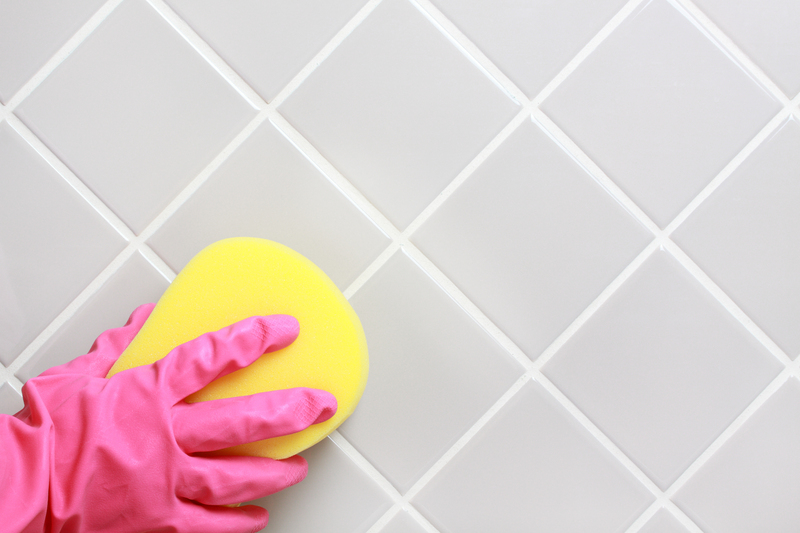No More Burnt-on Grime: Stovetop Cleaning Made Easy
Posted on 23/09/2025
No More Burnt-on Grime: Stovetop Cleaning Made Easy
If you've ever struggled with stubborn, burnt-on grime on your stovetop, you're not alone. Cooking delicious meals can often leave behind a tough mess, making kitchen cleanup a dreaded chore. But what if stovetop cleaning didn't have to be such a hassle? This comprehensive guide will show you easy, effective ways to keep your stovetop sparkling clean -- no more scrubbing your knuckles raw or resorting to harsh chemicals!

Why Stovetop Cleaning Matters
A clean stovetop is more than just visually appealing. Regular stovetop cleaning prevents unsightly burnt-on food and grease from building up, but it also extends the lifespan of your appliance, promotes safety, and ensures the flavor of your meals isn't compromised by lingering residues. Neglecting this important task can lead to:
- Potential fire hazards from accumulated grease and debris
- Unpleasant odors wafting through your kitchen
- Bacterial growth in hard-to-reach crevices
- Reduced efficiency of gas burners and electric coils
- Decreased home value due to neglected appliances
Understanding Your Stovetop Type
Before diving into stovetop cleaning tips, it's important to identify the specific type of stove in your kitchen. Each comes with unique cleaning requirements:
- Gas stovetops: Feature removable burner grates and caps, which can accumulate burnt-on food and grease.
- Electric coil stoves: Coils and drip pans are usually removable but may require special care with electrical components.
- Glass-ceramic or induction cooktops: Sleek and stylish, but prone to scratching if cleaned improperly.
*Proper stovetop maintenance begins with understanding your specific appliance!*
The Best Daily Habits for a Spotless Stovetop
The easiest way to prevent burnt-on grime is through daily maintenance. Follow these simple habits:
- Wipe down after every use - As soon as the stove cools, use a damp microfiber cloth or sponge to remove spills and splatters.
- Address spills right away - Don't let food dry and harden! Quick action makes cleaning far simpler.
- Use stove covers or liners - For electric coils or gas burners, reusable liners catch drips and grease, reducing mess.
- Check burner ports and igniters - Make sure burner holes aren't clogged, affecting performance and safety.
By implementing these easy habits, you'll save yourself hours of deep cleaning down the line -- and your stovetop will always look guest-ready.
How to Remove Burnt-on Grime from a Stovetop
For those times when messes get out of hand, and burnt grime on your cooktop seems impossible to remove, have no fear! Follow these step-by-step stovetop deep cleaning instructions tailored to your stove type:
Cleaning a Gas Stovetop
- Turn off the gas and disconnect burners if possible.
- Remove grates, burner caps, and knobs. Soak them in warm, soapy water for 20-30 minutes to loosen grime.
- Sprinkle baking soda on stubborn, burnt spots on the stovetop surface.
- Spray with a 1:1 solution of white vinegar and water. Let it fizz for several minutes, then gently scrub with a non-abrasive sponge.
- Use a soft brush (like an old toothbrush) on tiny crevices, burner ports, and around igniters.
- Rinse all parts thoroughly and dry before reassembling the stovetop.
Cleaning an Electric Coil Stove
- Ensure all burners are off and fully cooled.
- Remove coils and drip pans. (Never submerge the electrical connections in water!)
- Soak drip pans in hot, soapy water for 15-20 minutes. If needed, sprinkle with baking soda and scrub.
- Wipe coils carefully with a damp cloth. For tough spots, use a paste of baking soda and water, then wipe clean.
- Clean the cooktop surface with vinegar and baking soda as above.
- Dry all parts thoroughly before putting everything back together.
Cleaning a Glass or Induction Cooktop
- Wait for the cooktop to cool completely.
- Use a soft, damp cloth to remove loose debris.
- Sprinkle a light layer of baking soda on stubborn stains.
- Cover with a damp microfiber cloth, letting it sit for 10-15 minutes to loosen burnt-off food.
- Wipe in gentle, circular motions. For the toughest spots, use a stovetop scraper designed for glass surfaces (never a razor blade or abrasive pad!).
- Finish with a glass cooktop cleaner or a vinegar-water mix for a streak-free shine.
Must-Have Tools and Supplies for Stovetop Cleaning
- Microfiber cloths and soft sponges - For gentle cleaning without scratching.
- Baking soda and white vinegar - Natural powerhouses for breaking down burnt grime and grease.
- Old toothbrush - For getting into tough corners and around burners.
- Dawn dish soap or degreasing cleaner - Cuts through tough, oily messes.
- Plastic spatula or cooktop scraper - For safe removal of dried, burnt-on food (especially on glass surfaces).
- Cooktop-specific cleaner - Especially formulated sprays or creams for induction or glass stoves.
- Paper towels or lint-free towels - For drying and buffing to a shine.
Natural DIY Stovetop Cleaning Solutions
If you prefer to avoid store-bought cleaners, natural home remedies are both effective and eco-friendly. Here are some tried-and-true recipes for homemade stovetop cleaning:
- Baking Soda Paste: Mix 3 parts baking soda with 1 part water to create a thick paste. Spread on burnt spots, let sit for 15-20 minutes, then wipe away.
- Vinegar Spray: Fill a spray bottle with equal parts white vinegar and water. Spray liberally on greasy areas and wipe clean.
- Lemon Juice Cleanser: The natural acidity of lemon juice helps to break down grease while leaving a fresh scent. Mix lemon juice with a little salt for a gentle abrasive scrub.
- Hydrogen Peroxide & Baking Soda: For stubborn stains, sprinkle baking soda over the affected area and pour a little hydrogen peroxide on top. Let bubble, then clean as usual.
*These natural solutions are safe, affordable, and often as powerful as their commercial counterparts!*
Preventing Burnt-on Grime: Pro Tips for a Pristine Stovetop
The key to easy stove cleaning is prevention. Here are some expert-approved strategies to keep grime at bay:
- Use a splatter guard or lid when frying or simmering foods to contain messes.
- Clean as you cook -- a quick swipe of spills and splatters stops them from hardening.
- Deep clean weekly -- set aside 15 minutes once a week for a thorough wipe-down and check for buildup.
- Rotate burners if possible -- avoid repeatedly using the same burner, which can lead to uneven buildup.
- Apply a thin layer of car wax to glass/ceramic stoves monthly (wipe clean with a microfiber cloth) -- this creates a barrier that makes future cleaning much easier.
Product Recommendations: The Best Stovetop Cleaners on the Market
If you prefer commercial cleaning solutions for your stovetop grime problems, consider these popular products loved by home chefs and professionals:
- Weiman Cooktop Cleaner - Specially formulated for glass and ceramic surfaces; leaves a streak-free finish.
- Bar Keepers Friend - An all-purpose powder cleaner, safe for most stovetop materials.
- Easy-Off Kitchen Degreaser - Powerful, cuts through thick grease and baked-on food quickly.
- Magic Erasers - Micro-abrasive sponges for tackling tiny stubborn spots (test on an inconspicuous area first).
- Mr. Clean Multi-Surface Cleaner - Effective and convenient for daily wipe-downs.
Always read manufacturer guidelines to ensure cleaners are safe for your specific stovetop type.
Common Mistakes to Avoid When Cleaning Your Stovetop
- Using steel wool or abrasive pads on glass/ceramic cooktops -- these can scratch or damage the surface permanently.
- Cleaning a hot stove -- wait for the stovetop to cool before applying any cleaners to avoid burns and chemical evaporation.
- Excessive water use near knobs/burners -- can short-circuit electrical systems or corrode gas parts.
- Neglecting to dry components before reassembling -- leftover moisture can cause rust or poor ignition.
- Ignoring burnt-on stains for months -- early intervention is always easier and more effective!

Frequently Asked Questions: Stovetop Cleaning Made Easy
Can I use vinegar to clean my glass cooktop?
Yes! Vinegar is an excellent, gentle cleaner for glass and ceramic cooktops. Just be sure to wipe with a soft cloth and buff dry for a cloud-free finish.
What's the fastest way to clean a stovetop after a spill?
Wipe the mess with a damp cloth while it's still warm (not hot). Sprinkle a little baking soda if needed, and follow up with a quick spritz of vinegar for a sparkling surface.
Are commercial oven cleaners safe for stovetops?
Most oven cleaners are too harsh for stovetops, especially glass or induction surfaces. Always use products labeled as safe for cooktops to avoid damage.
How often should I deep clean my stove?
For the best results, deep clean your stovetop once a week and wipe up spills daily. This routine keeps grime at bay and prevents burnt-on messes.
Is it okay to soak burner grates and drip pans overnight?
Absolutely! For heavily burnt-on residue, soaking grates and pans overnight in soapy water often makes scrubbing much easier the following day.
Conclusion: Enjoy a Gleaming, Grime-Free Stovetop Every Day!
Say goodbye to burnt-on grime! With the right approach and a little regular attention, stovetop cleaning can be quick, easy, and incredibly satisfying. Whether you prefer natural DIY solutions or trusted commercial cleaners, these expert tips ensure your cooktop stays hygienic, attractive, and ready for your next culinary adventure.
Remember, a sparkling stove is the heart of a welcoming kitchen. Start your new cleaning routine today for a home that shines!
- Act fast on spills for effortless cleanup.
- Choose the right cleaning technique for your stovetop's material.
- Use gentle, non-abrasive tools to protect your appliance.
- Deep clean weekly for a grime-free, sparkling finish.
Now that you have all the tools, techniques, and insider secrets, stovetop cleaning will never be a dreaded task again. Enjoy a kitchen you're proud of... and a stove that's ready for every delicious creation!




